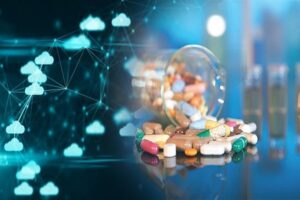Life Sciences
The future of pharma 10th November 2022
By Sylvian Tamier, Business Development Manager Biopharma, IMCD Group

The future of pharma: is biopharmaceutical and biotechnology the way forward for the industry?
With the pharmaceutical sector moving swiftly towards biopharmaceuticals and biotechnology, we have new household names that appear to be omnipresent, both amongst medical professionals and patients alike, but what do they really mean, why are they significant and what does this imply for future medical research and treatment? Ever since Covid-19 captured the world’s focus on recent developments in this area, biopharma seems an increasingly pertinent topic for the science industry to investigate.
What are biotech and biopharma?
Biotechnology is a wide term used to define the production of a molecule via a living organism that ranges from yeast fermentation in the food industry to the production of molecules via genetically-modified organisms (GMOs), which can be plants, bacteria, insects or mammalian cells.
Biopharma is more specific and revolves around the application of biotechnologies aimed at producing biological drugs (biologics). So, whilst biotech refers to every product produced via a living organism, biopharma focuses on drug products that are created via living organisms, often mammalian cells.
Biopharmaceutical advances
Biologics are bringing an effective answer to many modern illnesses, such as cancers and genetic diseases. Monoclonal Antibodies, for example, provide state-of-the-art treatment for many cancers, due to their targeted action on cancer cells. In comparison, classic chemotherapy (consisting of known chemical entities) is not targeted and often has (heavy) side effects for the patient. Gene and cell therapies go a step further by directly acting at the source of the disease by correcting a defective gene inside the patient’s cells.
Zolgensma is such an example. This is a gene therapy medicine used for treating spinal muscular atrophy (SMA), with costs of about $1.9 million per treatment. That said, only one to two injection treatments are needed and children suffering from this rare disease have a significant chance of complete recovery. This promise of success is one of the reasons why biopharma is becoming an increasingly talked about topic. When looking at the new FDA-approved drugs, most of them are monoclonal antibodies or gene therapy treatments. The recent Covid-19 pandemic also accelerated market approval for innovative approaches for vaccines, many of them being mRNAs or viral vectors.
Bottlenecks and challenges
Traditional medicines are made in chemical reactors. Biopharma refers to living organisms as chemical reactors.

For this, we need to know biology and biotechnology, genetics and gene-editing. Having the right gene-sequence is only one part of the story. Understanding biology and genetics and properly guiding them is a big bottleneck that affects both drug manufacture and drug efficiency. In addition, regulatory approvals and accessibility remain biopharma bottlenecks. Many biologics are currently benefiting from fast-track reviews and approval because they are bringing solutions to unmet needs for many patients. Biosimilars, which are the biologic version of ‘generic’ drugs, are another solution, which is targeting the high cost of biologic drugs for health care systems. Finally, manufacturers of biologics are benefiting more and more from standardised technical platform approaches (well-defined cell lines, cell culture media, processes and analytics), which allow for faster process development and provide a go-to clinic for those drugs. With the growing need for more biologics, there is an increasing gap in production capacity, thus driving the bio-CDMOs towards investing in manufacturing facilities, making them an indispensable part of the supply chain.
Supplier solutions
Suppliers can help on two sides: upstream production (drug substance) and downstream formulation (drug product). Upstream manufacturing revolves around the production of the monoclonal antibodies or the viral vector for gene therapy. Those molecules are manufactured via mammalian cells and they need chemically-defined and serum-free cell culture media. As a distributor, IMCD has the technical knowledge, the cell lines and cell culture media to support that.
If you have the right cell-media for the right cell type, you can increase the productivity and the robustness of the manufacturing of the drug substance.
At the same time, IMCD can help with the formulation of the drug products by supplying the right excipients. About 90% of final biopharma dosages, whether that be gene therapy or monoclonal antibodies, are sterile injectables. For this, special grade excipients with low endotoxin levels and low bioburden are needed. IMCD works with leading excipient providers that are dedicated to manufacturing the highest quality ingredients.
The need for excipients
One of the biggest challenges is the stabilisation of the proteins or the stabilisation of the liposome to stabilise the gene. It is necessary to protect the three-dimensional structure, since the activity of the molecule depends on the right configuration. For this, special grades of carbohydrates, polyols or polysorbates are needed. IMCD’s global biopharma champions can help guide customers through every stage of their biopharmaceutical product.
One thing is certain; biopharmaceuticals are going to be more and more crucial in the future world of medicine and treatments. We can look to current advances and research as an example of what could potentially be a common approach to grasp the synergy between therapies and technology.


